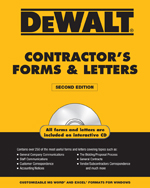
When I moved from the rain-drenched Evergreen State (Washington) to the sun-drenched Sunshine State (Florida), I realized right away that things really are different. First, there are a lot of seniors with retirement savings and investments being high on their minds. Second, there is a ton of litigation about construction. I learned quickly that here, litigation is almost considered a sport.
Once I settled in, I became acquainted with some people who work with retirement investment programs for small businesses. A particular program - which seemed suited for contractors - caught my eye. So I brought it to the attention of Walls & Ceilings. What follows is an interview by me going into the basics of the program with Mike Mitchell of Mitchell Capital Management, Inc., of Sarasota, Fla. By the time you finish, I think you’ll be as amazed as I was.
Rob Thomas: What is a Business Leveraged Retirement Income Program?
Mike Mitchell: Basically the program involves leveraging one asset in order to purchase another asset. In this case, we leverage the owner’s business with an interest-only loan. The loan proceeds are then used to set up a retirement income program for the business owner.
RT: It sounds like this could be complicated to set up. Is it?
MM: Not at all. We have helped hundreds of business owners through this process over the years and have developed a step-by-step program that is easy to understand and implement.
Once we have perfromed our review of the business, detailed illustrations are prepared and presented to the business owner. These illustrations spell out how the program operates on both a guaranteed and non-guaranteed basis over time. It is with this information that the business owner makes the decision whether or not to implement the program. We can work with the owner’s current bank or provide an outside lender to handle the lending. In other words, we bring all of the tools to the table.
RT: Are there any other benefits to the program besides planning for retirement income?
MM: Yes. While the primary function is to provide the owner with income for retirement, there are also business asset protection aspects to the program as well.
RT: How does this program protect the business?
MM: The first of the three main program components is the leveraging process. This step involves determining how much of a loan is needed to meet the business owner’s goals. Once the entire program has been approved by the owner, the lender issues a loan that is secured by the business assets. This is where the “business leveraged” part of the program takes place. After the loan has been issued, the lender files a UCC-1 lien securing the business as collateral.
Many of our clients’ goals require a loan amount that is larger than the value of the business. In this case, a lien is filed on the business for more than its liquidation value. This lien now requires future creditors with a judgment to pay off the principle amount of the loan before they can attach and liquidate the business assets. In this case, a creditor would have to pay more for the business than what it is actually worth.
RT: Has this actually protected a client’s business?
MM: While I can’t go into specific case information, the program, over the years, has been successful in deterring lawsuits. In other cases, the program actually encouraged what has been described as favorable settlements with a creditor. So, from an asset protection standpoint, the program was viewed as a success. Again, the program’s goal is to provide income in retirement, but by the nature of how it is structured, asset protection may also be a result.
RT: How does the UCC-1 work?
MM: The UCC-1, or Uniform Commercial Code, was developed over time as a way to promote uniformity among various jurisdictions to govern commercial transactions. Each state has adopted its own guidelines, although recently, new federal guidelines have been adopted to standardize the process. A UCC-1 Financing Statement is a form that is filed with your state. It is a legal document filed by a lender and signed by a borrower, which specifically lists property the borrower has assigned to the lender as collateral against the debt. It shows the lender as a secured party of record, and assists in determining who has rights to your assets. All lenders will file a UCC-1 financing statement with the state government in order to protect their investment in your company.
RT: You mentioned there are three components to the Business Leveraged Retirement Income Program. What are the other two?
MM: While there are several moving parts to the program it basically boils down to three main components. We have already talked about the leveraging process being the first. The second component is the legal structure. Not wanting to get too “legal” here, but this part of the program determines how the loan proceeds and the interest payments will affect the business and the business owner from a tax standpoint.
The third component of the program is the retirement income vehicle. This is where the loan proceeds are actually deposited. Every program relies on either an annuity contract and or a life insurance policy to grow the loan proceeds in a compounded, tax-deferred manner. The specific information about how these contracts function is presented to the business owner by way of policy illustrations prepared by the issuing insurance company.
RT: How does the retirement income money accumulate?
MM: The entire principle amount of the loan has to be deposited into the chosen insurance contracts and cannot be used for any other purpose. Once the insurance contracts are funded, they compound and grow tax deferred. This compounding effect is what causes the cash values of the contracts to accumulate faster than the simple interest cost associated with the loan. You have to remember that with this program, as with all things, time is money. The longer the program is in place the greater effect the compounding will have. A plan that is in place for 10 years will not likely provide the same retirement income benefits as one in place for 15 years or more.
RT: How is the retirement income money drawn out at the dissolution of the business?
MM: At retirement the owner can use the cash value that has accumulated in the insurance contracts to provide retirement income as well as pay off the loan balance. The decision of how much and when to start the income stream is made at retirement. The amount can also be adjusted depending on the current and future needs of the owner and is also monitored to ensure the policies remain in force.
RT: What is the dollar cost to the business owner for this program? Are there ongoing fees?
MM: Depending on the lender, most loans will have a loan origination fee along with a UCC-1 filing fee. There may also be local or state fees associated with the loan depending on the state in which the business is located. These are generally minimal one-time-only fees.
The only other “fee” is the monthly interest cost of the loan. This expense is a function of the interest rate applied to the loan amount. There may also be tax-reporting costs depending on how the program is structured. While we do not provide tax advice, we do work with the business owner and their tax advisors to determine the appropriate reporting structures for the program.
RT: Does this program have limitations as to where it can be used (which states)?
MM: No. The program can be used in any state. The three main components of the program take into account the state where the business is located. Any variations to the program from state to state will be transparent to the business owner.
RT: What if the business owner wants to terminate the program?
MM: I’m glad you asked this question. While our clients are planning for the future of the business and their individual retirement, sometimes the unexpected happens. The business owner can end the program at any time by paying off the loan. One way to satisfy the loan would be to use the proceeds from the sale of the business. The cash values of the insurance policies could also be used to satisfy the loan. The policy illustrations we provide to the client at the very beginning of the process will show what the guaranteed cash surrender value of the policies will be at any point in time. In other words, the business owner will know in advance what the cash surrender value of the policies will be on a guaranteed basis. This is critical information for a 45-year-old who starts a retirement income program planning to retire at age 65 and suddenly needs to exit the business and the program at age 51.
RT: Can the program be transferred to a new owner?
MM: Yes. At any time, the original owner’s loan can be paid off since these loans are not subject to prepayment penalties. The new owner can then start a new business leveraged retirement income program for themselves. Additionally, when there is more than one owner of the business, each partner can choose when to retire or leave the business independently of the other owners. The program is simply adjusted with each change in ownership status.
RT: How long does the program last?
MM: The program can remain in place for as long as needed or until the retirement of the owner. The program is very flexible.
RT: What happens to assets that come and go over the life of the program? Some contractors buy expensive equipment, which eventually wears out or is sold. How is that accommodated? Does the program require on-going maintenance, and who handles that?
MM: In most cases these types of changes are not a problem for the program or the business given how the collateral is structured for the loan. Again this is part of our review process with the business.
RT: Does the program require the contractor to provide any specific level of insurance (some building project contracts and states require a certain level of various types of insurance)?
MM: Yes, depending on the collateral and the lender. However in most cases the required insurance is of the type that is already carried by the business.
RT: What if the owner has already leveraged a portion of the business for some other purpose?
MM: Each case is different but normally this is not an issue.
RT: What would be the minimum business volume (dollars per year?) that would make sense for a program like this?
MM: The determining factor is not so much the annual gross sales of the business but the retirement income goals of the owners. A company with $500,000 in annual collections would not be able to put a $1 million plan in place, but they could start a program for an amount up to $500,000.
Your question is a very common one and it normally revolves around the question of “Is this type of program only for a very large company.” The answer is no, it works for companies of all sizes.
RT: Also, what happens if the business’s assets increase (say they buy a building not originally included in the program), or sell off one portion of the business (say, keep the interior painting work portion but get out of the exterior stucco work)?
MM: We know from experience that almost every business will grow or experience changes over time. To make sure that the program stays in balance with its original goals we conduct annual reviews of the business and the owners.
RT: Can this program be used by building product distributors?
MM: This program can be used by any closely held company. It could be a mom and pop corporation or a business collecting $100 million owned by 50 partners. We literally do not have a ceiling, no pun intended, on the size of the program we can put in place. The only restriction is that publicly traded companies cannot participate in this type of program.
RT: What kinds of businesses will this work with?
MM: Any entity that has its own tax ID number.
RT: I assume that if the business entity has a board or shareholders, that this sort of program has to go through some type of legal/accounting/business approval process, right?
MM: We require that all “owners” of the business agree to the lien being placed on the business. If the company structure requires additional approval then that has to be addressed as well.
RT: How do you make your “cut” in this? Is it a one-time fee for setting up the program, or an ongoing fee?
MM: Neither the business nor the business owners pay any fee to us. We also are not paid any fees by the lenders for placing the loans with them. We use the lender that brings the best terms to the table. We earn our fees from the compensation that is paid by the insurance companies. So, the only ongoing cost to the business or the business owners is the interest expense of the loan.
RT: Who would be the ideal candidate for this program?
MM: Basically any owner of a closely held business that wants to supplement their retirement income can participate and benefit from this program.
RT: Would it be possible to give a basic example of a theoretical program, with two partners with, say, $15 million in annual billings and $500,000 in assets (equipment, trucks, warehouse, etc.)?
MM: I prepared a hypothetical example of how the program would work for a Florida construction company owned by two 45-year-old partners with $15 million in annual collections and approximately $500,000 in company assets.
First a short disclosure. Your readers should understand that each business and its owners will have their own set of facts that will determine how their program is designed. No conclusion should be made that every program will work exactly like this hypothetical example. Certainly in a real presentation to a client we would provide full documentation and illustrations for their review, which we can’t provide in this setting. There are non-guaranteed elements to the illustrations and they are subject to change and can result in an outcome that is either higher or lower than in this hypothetical example.
In this hypothetical example I assumed the owners were in good health and that they wanted to retire at age 65. A $1,000,000 interest-only loan was obtained and was used to fund two separate $500,000 Business Leveraged Retirement Income Programs, one for each partner. The construction company was used as collateral for the loan. Assuming a fixed annual interest expense of $72,000 per year (7.2 percent) the total interest expense after 20 years would be $1.4 million.
On the retirement side of the program, each partner’s life insurance policy is projected to provide approximately $1,900,000 in initial death benefits. At age 65, each partner is projected to receive $240,000 per year for 15 years, or $3,600,000 assuming the policy’s illustrated non-guaranteed interest rate.
On the asset protection side, the business has operated for 20 years with a $1,000,000 lien filed against it while its assets were worth $500,000. Any future creditor with a judgment would have to first payoff the $1,000,000 loan before they could attach and liquidate the company assets of $500,000. It would not be considered a profitable transaction to pay $1,000,000 for something that is worth $500,000 and makes the business an unattractive target to future creditors.
RT: Those of you who are regular readers of W&C, know that I’m an engineering type person and deal mostly with EIFS wall system issues. From the above synopsis, even a nerd like me can see some eyebrow-raising incentives for getting involved in this sort of program, even for such humble purposes like “money” and “peace-of-mind.”







Report Abusive Comment